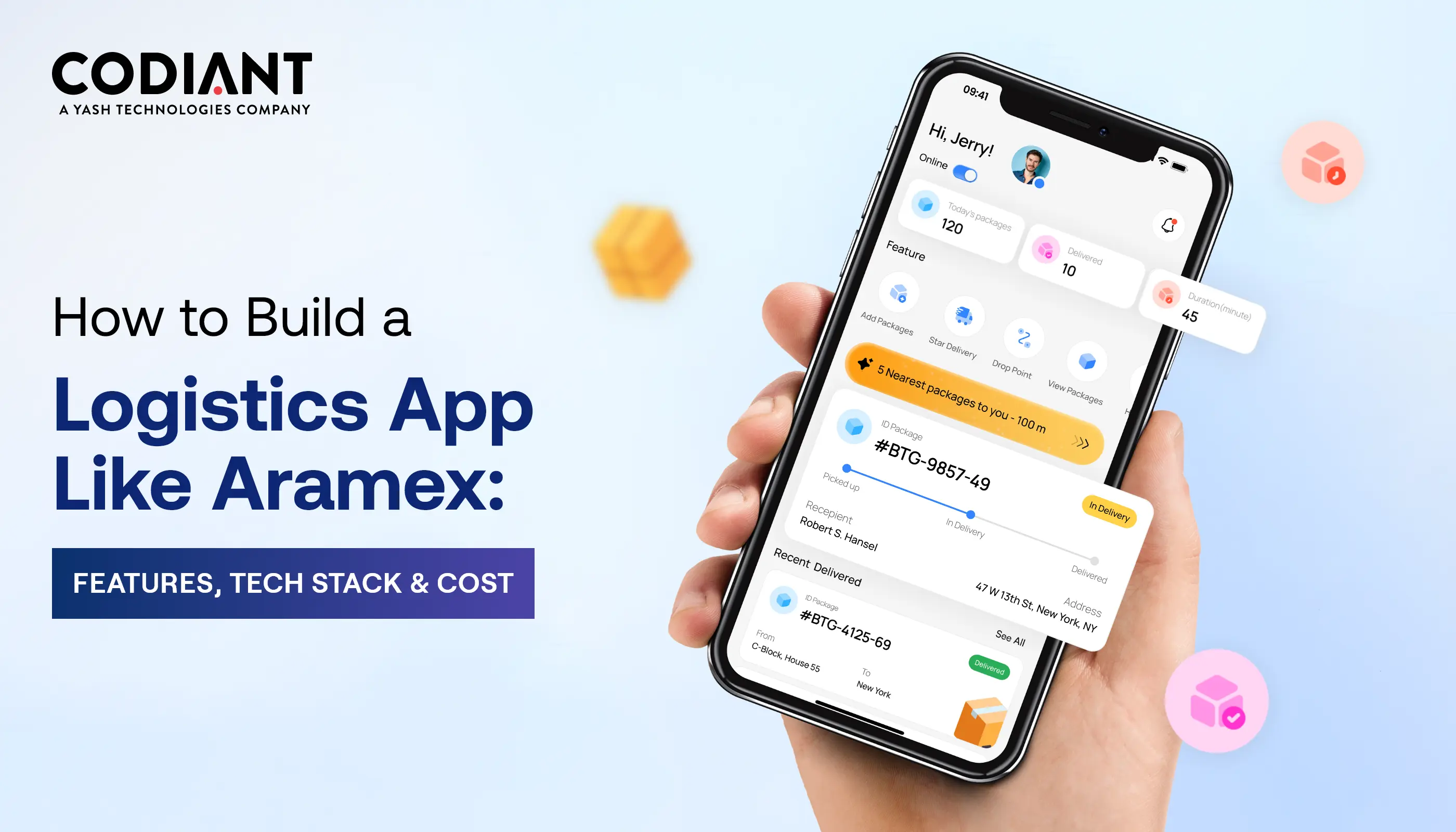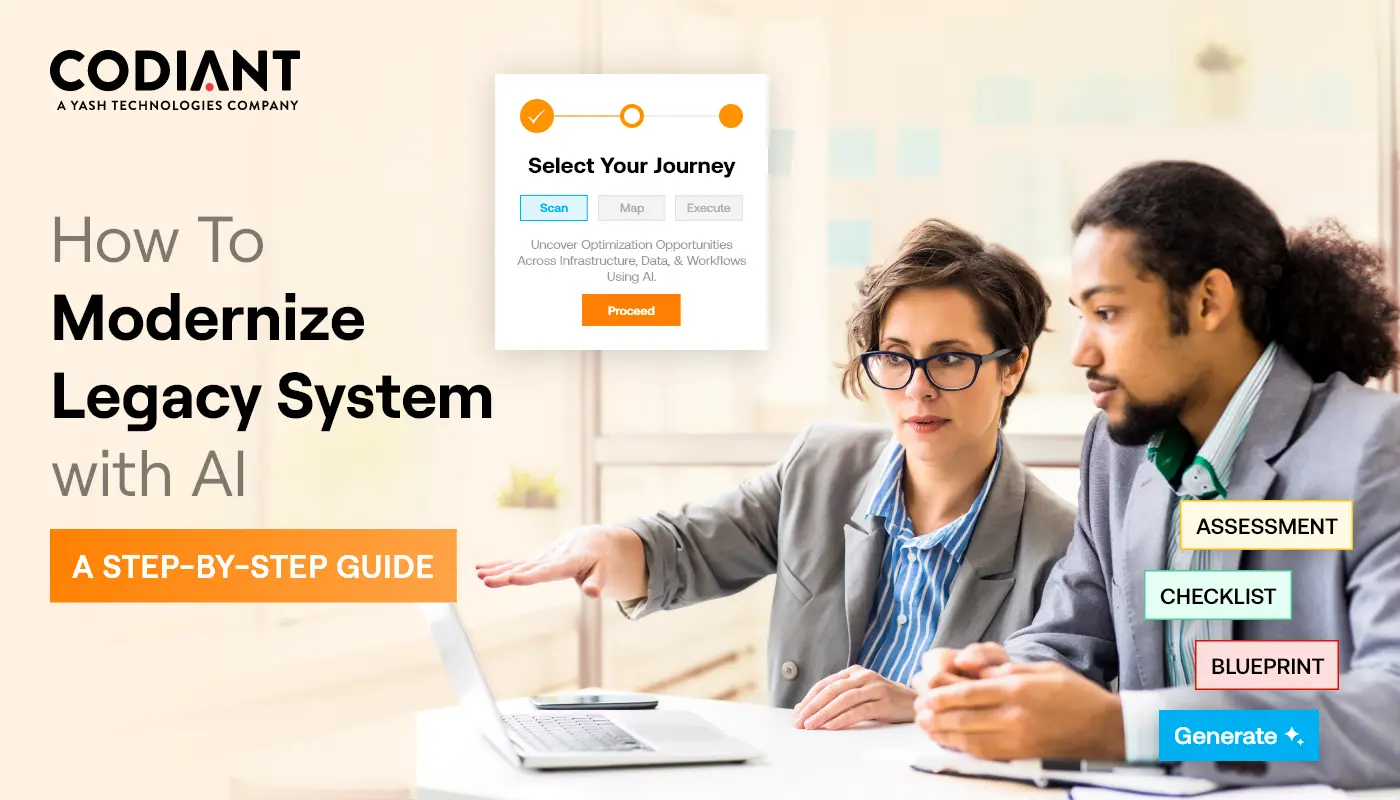Learn How to Build AI Agents That Can Speed Up Your Work and Reduce Other Expenses
Table of Contents
Subscribe To Our Newsletter
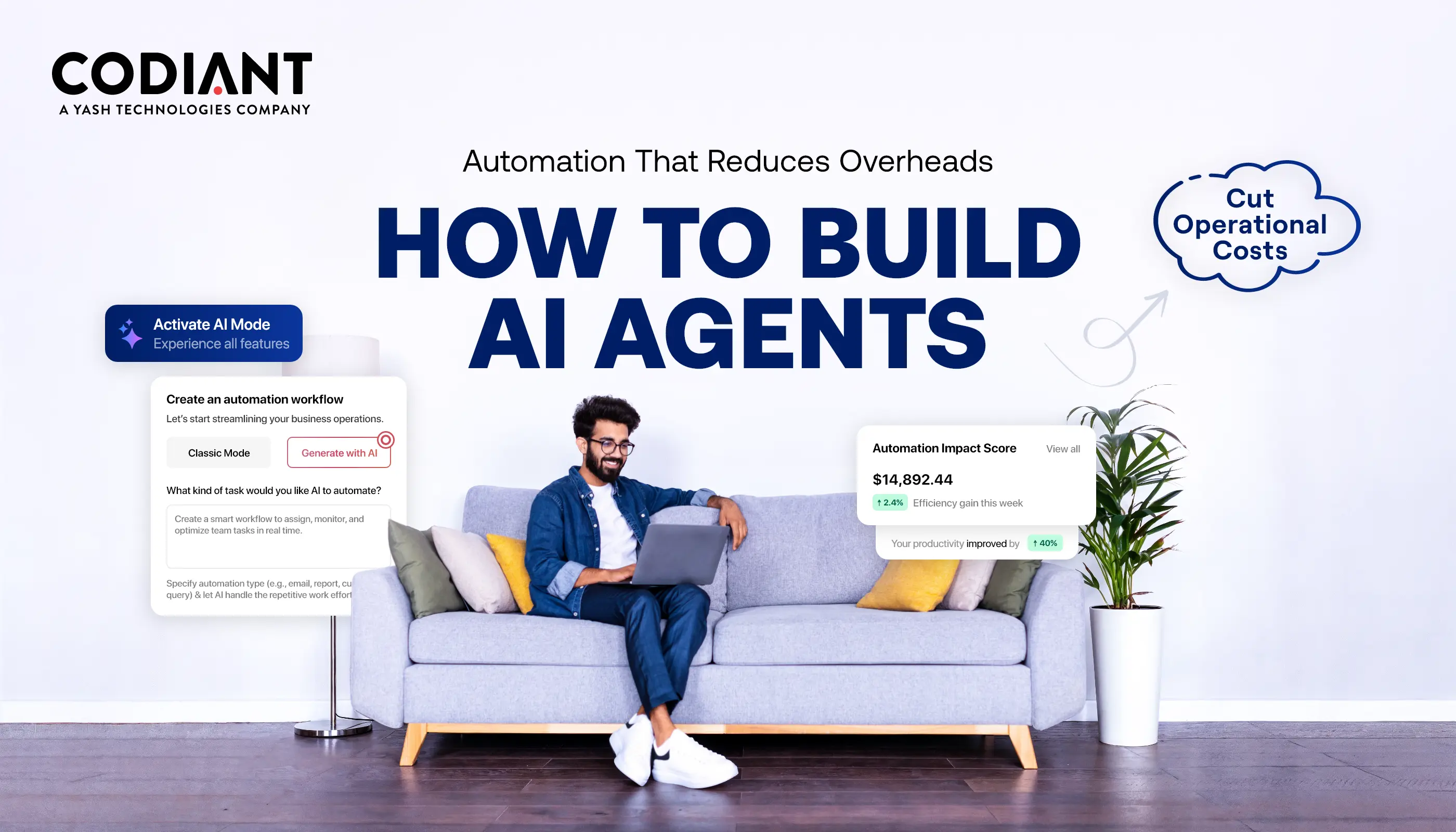
Businesses today are looking for faster ways to work and smarter tools that cut costs. That’s why AI agents are quickly becoming a key investment for companies of all sizes. These autonomous systems can perform tasks on their own, reduce manual work, and improve overall productivity.
If you’re wondering how to build AI agents from scratch, this guide will show you the exact steps. You’ll learn how to build AI agents for business automation, how they support workflow automation, and how companies are using them as cost-saving AI solutions for enterprises.
As AI agent development in 2026 continues to advance, organizations are shifting from basic chatbots to autonomous AI agents that can analyze data, make decisions, and take real actions. The best part is that they don’t just automate tasks—they help unlock measurable productivity improvement across teams.
In this blog, we’ll explain what AI agents are, how they work, the tools needed to build them, real business use cases, and a practical roadmap to launch your own AI-powered automation.
Let’s dive into the future of work—starting with your first AI agent.
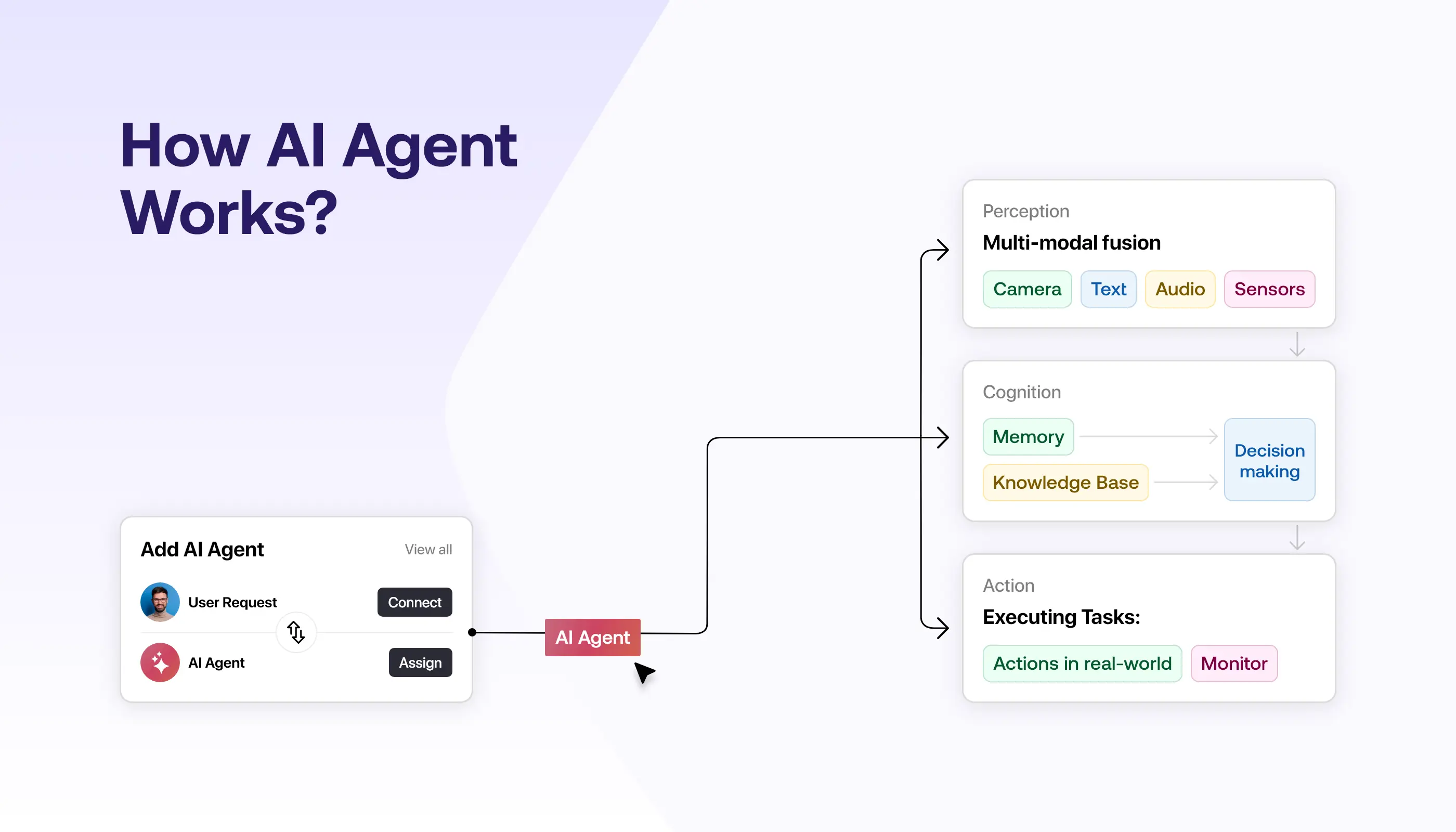
What Is an AI Agent and How Does It Work?
An AI agent is a software system that can observe data, make decisions, and take actions with minimal or no human input. Unlike regular automation scripts or rule-based bots, AI agents are designed to think, learn, and adapt as they interact with users and environments. This makes them ideal for intelligent automation using AI agents in real business operations.
An AI agent works through four core functions:
- Sensing – It gathers information from various sources like CRMs, emails, APIs, or user inputs.
- Reasoning – It uses AI models to analyze data and decide what needs to be done.
- Acting – It performs actions automatically, such as updating databases, sending emails, or generating reports.
- Learning – It improves over time using past actions, feedback, and new data.
Today, companies rely on AI workflow automation tools to integrate these agents into everyday tasks like customer support, IT ticketing, finance approvals, and marketing operations. By taking over repetitive workflows and optimizing decisions, AI agents help organizations deliver faster execution, improved accuracy, and better customer experiences.
In simple terms, an AI agent is not just a tool you command — it’s a digital worker that gets work done for you.
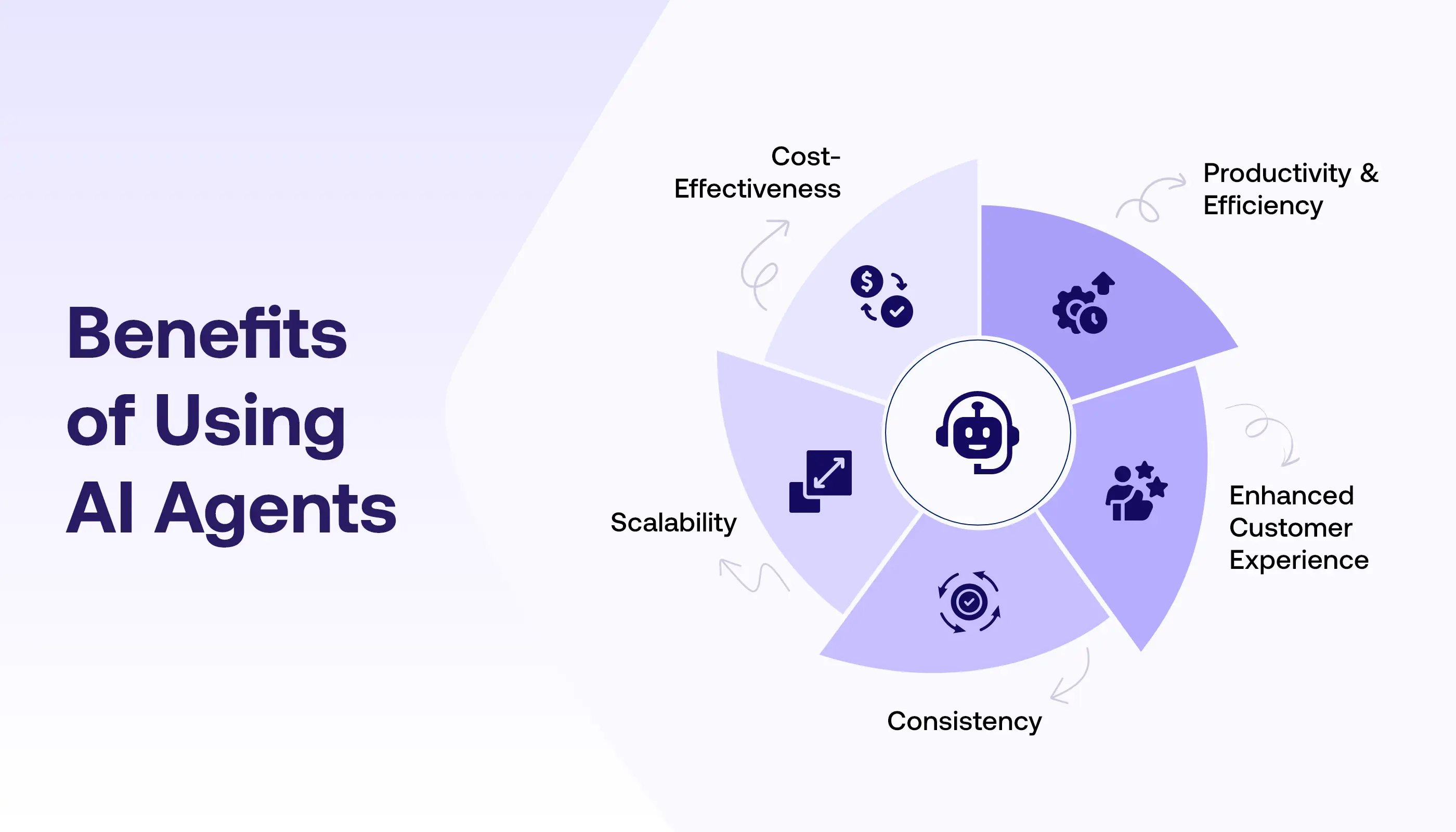
Why AI Agents Matter for Businesses Today?
AI agents are transforming how work gets done. They eliminate slow, manual processes and support employees by taking over repetitive activities that consume time and energy. This directly answers a key question many leaders have: How do AI agents improve employee productivity and efficiency?
They free up teams to focus on strategic, creative, and revenue-generating tasks — not data entry, ticket follow-ups, or approvals.
So, which industries benefit most from using AI agents?
The truth is, nearly every industry can see gains — but the fastest adoption is happening in:
- Banking & Insurance — Faster claims, fraud checks, compliance workflows
- Retail & eCommerce — Automated customer support, inventory alerts, dynamic pricing
- Healthcare — Appointment handling, care coordination, documentation support
- Logistics & Transportation — Route optimization, delivery tracking, dispatch automation
- Manufacturing — Production monitoring, predictive maintenance, safety compliance
- Real Estate & Property Management — Inquiry responses, tenant workflows, document processing
These examples show which industries benefit the most from AI agent implementation: the ones handling large volumes of operational tasks that must be done accurately and fast.
The result?
Lower workload, fewer errors, and faster execution across the business. AI agents are not replacing people — they’re removing business friction and helping teams work smarter every day.

How to Build AI Agents Steps-by-Step
If you’re wondering how to build AI agents from scratch, the process starts with a clear understanding of what tasks they will automate and how they will interact with your systems. Below is a practical roadmap that helps you build AI agents step by step for real business automation.
Step 1: Clearly Define Your Agent’s Mission
Every successful AI agent starts with a strong reason to exist. Without a mission, it might process data and run algorithms — but it won’t deliver real value. So before touching any framework or model, get absolute clarity on what outcome you want the agent to drive.
Think about:
- Which challenge is it solving?
- Who benefits from it?
- What inputs must it understand? (voice commands, documents, images, system logs)
- What kind of decisions must it take — advisory or fully autonomous?
- How independent should it be in acting on those decisions?
This step acts like your blueprint. It helps you avoid feature overload, choose the right data sources, and design intelligence that matters.
Mission Examples
|
Agent Use Case |
Core Objective |
| AI Helpdesk Assistant | Reduce support queues by giving instant, accurate responses |
| Email Prioritization Agent | Separate critical messages from noise and suggest next best action |
| AI Sales Outreach Agent | Personalize messages based on buyer intent and automate follow-ups |
Pick the Right Agent Type Early
|
If you need this… |
Select this agent type… |
What it does best |
| Strict logic, predictable workflows | Reactive Agent | Responds instantly using preset rules (no memory of past interactions) |
| Learning from recent events to enhance decisions | Limited Memory Agent | Uses short-term data (last few actions, user behavior) for improvements |
| Multi-step planning, reasoning, and goal achievement | Goal-Based Agent | Evaluates future actions and selects the best route to a defined goal |
| Continuous learning and evolution from long-term data | Learning Agent | Improves over time using feedback loops and model retraining |
| Working alongside humans to achieve shared objectives | Collaborative/Assistive Agent | Fills operational gaps, boosts productivity, and co-pilots tasks |
| Communicating and coordinating with other agents | Multi-Agent System (MAS) Agents | Divide work, negotiate tasks, and accomplish large goals collectively |
| Predicting user intent and taking autonomous action | Belief-Desire-Intention (BDI) Agent | Uses internal mental models for advanced decision-making |
| Managing complex, dynamic environments like robotics | Hybrid/Hierarchical Agent | Combines multiple agent styles for balanced control + adaptation |
| Executing tasks through real-world movement and sensors | Robotic/Embodied Agent | Navigates physical environments using perception and action loops |
| Handling generative tasks (text, voice, images, code) | Generative AI Agent | Creates content and executes actions based on intent/knowledge |
| Acting based on social cues, norms, and policies | Social/Normative Agent | Ideal for conversational AI, negotiation, communities, moderators |
Step 2: Gather and Format the Right Training Data
An AI agent is only as smart as the information it learns from. Think of data as its learning material—if the content is messy, incomplete, or inaccurate, the agent will end up making flawed decisions. Strong, clean, and relevant data is the foundation of a reliable AI workflow.
Start by collecting examples of real interactions the agent is expected to handle. These could include:
- Conversation histories: Chat messages, support case notes, customer queries, or email exchanges that mirror expected user conversations.
- Knowledge resources: FAQ documents, product manuals, help articles, and internal knowledge bases—these help the agent respond accurately to informational queries.
- Voice samples: If your agent supports speech, gather audio clips that represent different languages, accents, tones, and ways people naturally talk.
- Usage logs: Historical data from existing systems can highlight common patterns, recurring issues, and user preferences.
Once collected, the data must go through two essential processes:
Data Cleaning
Remove anything that introduces confusion—unusable text, irrelevant responses, formatting errors, duplicates, or audio distortion. The goal is to leave behind only what will help the agent learn accurately.
Data Labeling
Add meaningful tags to help the model understand the intent behind user actions. For instance, classify messages like:
- “Book a table for two” → Reservation intent
- “What time do you close?” → Store-hours query
Clear labels allow the AI to connect different ways of asking the same thing, ensuring it responds with precision and context awareness.
Also read: Choosing the Right AI Agent Development Company: A Guide for Businesses
Step 3: Choose the Right AI Agent Architecture
Once you know what tasks you want to automate and the level of autonomy required, the next step in how to build AI agents step by step is choosing the most suitable AI agent architecture. This decision directly impacts how the agent behaves, how it makes decisions, how much control it has, and how well it scales across business workflows.
AI agents can be structured in different ways based on their purpose:
- Single-Task Architecture
Designed to perform one workflow extremely well — such as assigning tickets, sending reminders, or generating weekly reports. These agents are simple, cost-effective, and ideal for early-stage automation where goals are narrow and clearly defined. - Multi-Agent Architecture
Multiple specialized agents collaborate and divide responsibilities. For example, one agent may extract data from documents while another validates it and a third updates the ERP system. This architecture offers better performance for complex operations and enables parallel execution with fewer bottlenecks. - Autonomous / Agentic Architecture
These agents don’t just follow fixed rules — they plan, reason, evaluate outcomes, and self-correct. They can use tools, interact with external systems, and achieve goals independently. This is recommended for businesses aiming for advanced operational intelligence and long-term scalability.
Key Design Choices to Consider
- Observation & Environment
How will the agent receive information? Through user prompts, system events, APIs, or monitoring dashboards? - Decision-Making Approach
Will it use predefined logic, LLM reasoning, or reinforcement learning to choose an action? - Tool Usage
Can it call external APIs, update CRMs, trigger workflows, or execute scripts?
(Example: HubSpot APIs, Slack bots, database connectors) - Memory & Context Retention
Does the agent need long-term memory, short-term in-task memory, or both? - Governance & Human-in-the-Loop Control
Who oversees the agent’s decisions, and when should approvals be required?
Recommended Frameworks & Platforms
These tools make architecture implementation faster and more reliable:
- LangChain — building tool-enabled decision agents
- AutoGen — creating multi-agent AI systems that collaborate
- CrewAI — structured, role-based teamwork between agents
- Azure AI Agents — enterprise-grade agent deployment with security controls
- Rasa — best for conversational agents with workflow logic
- Zapier AI / Make — automation connectors for system integration
These frameworks help reduce development time while ensuring your agent is robust, scalable, and capable of interacting with real business tools.
Step 4: Select the Right Tech Stack for Your AI Agent
Once you know what the agent must accomplish, the next step is choosing the right development stack — the language, libraries, and agent frameworks that fuel its intelligence and autonomy. The selection depends on whether your AI agent needs to read text, process voice, understand images, integrate with tools, or perform multi-step tasks independently.
Programming Languages for Modern AI Development
The right language accelerates development and simplifies scaling:
- . Python – The modern AI backbone
- Simple syntax + rich ML ecosystem
- Has strongest support for agent frameworks
- Trending tools: FastAPI, LangGraph for agent workflows
- Best for: NLP, data-driven reasoning, RAG agents, deep learning
- C++ – AI with high-speed reasoning
- Ideal for robotics, embedded and AR/VR
- Trending tools: TensorRT, NVIDIA CUDA graph execution
- Best for: autonomous machines, gaming AI, computer vision robots
- JavaScript – For AI inside the browser
- Enables real-time inference on websites
- Trending tools: ONNX Runtime Web, WebGPU-powered models
- Best for: web chatbots, UI-integrated AI, browser ML utilities
- Java – Enterprise-grade performance
- Stable, scalable, secure
- Trending tools: Deeplearning4j, Java bindings for LLM APIs
- Best for: BFSI automation, fraud detection, secure AI services
Machine Learning & Decision Intelligence
These platforms help the agent learn, improve, and predict outcomes:
|
Tool |
Purpose |
| TensorFlow / PyTorch | Deep learning + high-level training |
| Scikit-learn | Classic ML (clustering, classification) |
| MLflow | Model lifecycle + monitoring |
| Vertex AI / AWS SageMaker | Managed MLOps + enterprise deployment |
Ideal for behavior prediction, ranking systems, operational AI
Natural Language Processing (NLP)
For agents that understand text or interact through chat:
|
Tool |
Purpose |
| Hugging Face Transformers | Plug into GPT, BERT, Llama models |
| spaCy | Real-time language tasks |
| Haystack | Search + RAG pipelines |
| Cohere / OpenAI APIs | Advanced reasoning + conversation |
Ideal for customer support bots, knowledge assistants, multilingual AI
Speech & Voice Recognition Technologies
For voice assistants, call bots, transcription agents:
|
Tech |
Strength |
| Whisper (OpenAI) | Industry-leading transcription & translation |
| Google Speech API | Cloud real-time recognition |
| Riva (NVIDIA) | Low-latency speech on edge devices |
| AssemblyAI | Speech intelligence like sentiment/emotion |
Ideal for Voice AI agents, medical dictation, IVR call automation
Computer Vision for Visual Agents
For agents that analyze visuals in real time:
| Tool |
Best For |
| OpenCV | Real-time image/face detection |
| YOLOv8 | High-accuracy object recognition |
| MediaPipe | Gesture/body tracking |
| SAM (Segment Anything Model) | Image segmentation with minimal labeling |
Ideal for surveillance, retail vision AI, healthcare imaging
Tools for Web-Based AI Assistants
Used to deploy or embed agents in digital products:
|
Platform |
Best Use Case |
| Rasa | Custom on-prem chatbots |
| Dialogflow CX | Low-code agent design |
| Next.js + Vercel AI SDK | Web UI + streaming AI responses |
| TensorFlow.js | Run models fully in browser |
Ideal for self-serve support agents, lead qualification bots, ecommerce AI
Step 5: Design & Develop Your AI Agent
After defining the requirements and clarifying the tech stack, the next key step is designing how the AI agent will think, reason, and interact.
This stage shapes the intelligence, usability, and operational connections that ultimately determine whether the agent succeeds in practical environments.
1. Choosing the Core Intelligence
The first decision revolves around selecting the model that will power your agent. Some solutions benefit from adapting robust, pre-trained foundation models like GPT or Claude, especially when natural language understanding is critical.
Others may demand custom-built models trained exclusively on domain-specific data for higher control and accuracy. The right choice depends on task complexity, expected autonomy, compliance obligations, and the level of personalization your business requires.
The model becomes the brain of the agent, so selecting the right one ensures every interaction delivers value.
2. Designing the Interaction Workflow
Next, define the internal flow of how the agent processes an incoming request and transforms it into a meaningful outcome.
This includes mapping how the agent detects intent, retrieves relevant knowledge, performs reasoning, and responds or executes actions.
It is equally important to plan for error handling—such as ambiguous queries, missing information, or system downtime—ensuring the agent behaves responsibly even in unexpected situations.
A thoughtful workflow reduces friction, shortens task completion time, and strengthens user trust.
3. Defining the User Experience
If the agent interacts directly with end users, its interface design becomes a crucial success factor. Conversations should feel intuitive, adaptive, and human-like, maintaining clarity even when dealing with complex requests.
Interfaces may support text, voice, or visual inputs depending on user needs. By focusing on smooth navigation, clear guidance, and minimal effort from the user, you ensure that the AI adds convenience rather than complexity. A strong UX accelerates adoption and encourages ongoing engagement.
4. Planning the Technology Stack
Your AI agent needs a robust technology foundation to operate efficiently. This involves selecting development frameworks, programming languages, deployment infrastructure, vector databases, and integration middleware.
Whether using Python with orchestration tools like LangChain or opting for platforms like Rasa for dialog automation, the stack must support scalability, security, and a rapid release cycle.
The goal is to create an environment where the agent can continuously evolve without major system redesigns.
5. Establishing Integration Points
No AI agent operates in isolation, so this step involves mapping how the system will connect with internal tools and external services.
It may require syncing with CRMs, payment gateways, scheduling systems, or secure enterprise data repositories.
This integration planning includes establishing authentication protocols, monitoring data flow, and safeguarding sensitive information through encryption and compliance standards.
Well-aligned integrations allow the agent to execute real actions instead of just delivering insights.
6. Building a Feedback and Optimization Loop
Finally, design mechanisms that allow the AI agent to learn and improve from real usage. User feedback, performance analytics, and error patterns should feed into regular iteration cycles.
Over time, this enables refinement of language understanding, better prediction accuracy, and greater operational efficiency.
A structured feedback loop ensures that your agent evolves alongside business needs and delivers increasing value after deployment.
Step 6: Train Models + RAG + Memory System
To make your AI agent intelligent and context-aware, you need a strong data and learning foundation. Start by training or fine-tuning your model using business-specific data — such as process documentation, product catalogs, knowledge bases, internal FAQs, and past interactions. This enables the agent to respond accurately based on company-approved information instead of generic assumptions.
Next, implement RAG (Retrieval-Augmented Generation). RAG allows the agent to fetch verified data from a Vector Database or private knowledge source before generating a response. This significantly lowers hallucinations and ensures better decision-making.
A memory system is equally important. Some agents only require short-term memory, like remembering a conversation flow. Others need long-term memory to store customer preferences, past task results, or business rules. This ability to recall and improve over time helps agents become more autonomous without losing control or accuracy.
Overall, this combination — trained models + RAG + memory — transforms your AI agent from a basic responder into a goal-oriented system that understands context, learns from outcomes, and keeps improving.
Step 7: Integrate with CRM/ERP & Internal Tools
Intelligent automation works only when the agent can take action inside your systems. That means integrating it with tools teams already use:
- CRM (Salesforce, HubSpot, Zoho)
- ERP (SAP, Oracle NetSuite, Microsoft Dynamics)
- HRMS & ATS platforms
- IT Service systems (ServiceNow, Jira)
- Communication tools (Slack, Teams)
These integrations allow the agent to automatically update records, assign tasks, generate tickets, trigger workflows, and push real-time alerts. Instead of being just “smart,” your AI agent now becomes truly operational, reducing manual touchpoints and closing process gaps.
Step 8: Testing → Safety → Guardrails
Before scaling automation, ensure that the agent performs reliably under different scenarios.
Testing must include:
- Workflow validation and business logic
- Data security and compliance checks
- Fail-safe paths and error-handling rules
- Human approvals for high-impact decisions
Guardrails prevent unauthorized actions, over-automation, or incorrect output from spreading across the business. Governance ensures the agent remains compliant with internal policies and industry regulations like GDPR or HIPAA. With the right safety framework, you maintain full control — even as your AI agent gains more autonomy.
Step 9: Continuous Evaluation & Scaling
Once deployed, measure how effectively the agent performs compared to before. Track improvements such as:
- Time saved per task
- Cost reduction in operations
- Higher employee productivity scores
- Increased workflow accuracy and throughput
- Better SLA compliance and customer satisfaction
Use these insights to refine prompts, optimize data pipelines, expand tool coverage, or introduce new skills for the agent. Success in one team can then be replicated across the organization, building a scalable ecosystem of automation.
Businesses that continuously monitor and evolve their AI agents experience compounding benefits — faster workflows, lower expenses, and stronger digital competitiveness.
Ready to Build Your First AI Agent?
Turn one repetitive workflow into smart automation that delivers measurable savings from day one – no guesswork.
Cost to Build AI Agents
Investing in AI agents is one of the fastest ways for businesses to streamline operations and cut down recurring expenses. However, the cost varies based on how autonomous the system needs to be, the workflows it automates, and the degree of integration with internal tools like CRM, ERP, EHR, or accounting platforms. If you are exploring cost-saving AI solutions for enterprises, here’s a realistic breakdown to help you plan smarter.
Development Cost Breakdown
|
AI Agent Type |
Ideal For |
Estimated Cost Range |
| Task Automation Agent | Simple, rule-based workflows such as data entry, appointment scheduling, ticket routing | $10K – $50K |
| Multi-Agent Autonomous System | End-to-end intelligent automation with decision-making, cross-department workflow orchestration, compliance checks, and continuous learning | $40K – $250K+ |
These estimates depend on:
- Level of autonomy (assistive → fully autonomous agents)
- Number of integrations (Slack, Salesforce, SAP, HubSpot, Zendesk, etc.)
- Domain-specific intelligence (finance, healthcare, supply chain)
- Security and compliance requirements (HIPAA, GDPR, PCI-DSS)
- Training data availability and AI model complexity
Deployment & Ongoing Maintenance Costs
Even after development, AI agents require:
- Continuous model updates
- Performance monitoring
- Knowledge expansion
- New tool/API connections
- Security upgrades & governance
Budget approximately 15–25% of initial development cost annually for smooth operations and future enhancements.
ROI: How AI Agents Reduce Operational Costs
Smart automation introduces significant financial benefits within months. On average, businesses experience:
- 20–45% reduction in operational costs in the first year
- Faster delivery cycles and fewer manual errors
- Increased employee productivity (teams can focus on revenue-driving tasks)
- Improved customer service outcomes without scaling headcount
When built correctly, AI agents pay back the initial investment rapidly and continue delivering compounding value as autonomy increases.
Related reading: AI Agents in 2025: Transforming Business, Redefining Leadership, & Accelerating Digital Transformation
Top Business Use Cases of AI Agents in Enterprises
AI agents are becoming key drivers of automation in large organizations. They help streamline operations, reduce manual intervention, and execute tasks faster than traditional tools. Here are some of the most impactful AI agent use cases in enterprise environments:
1. Automated Customer Support
AI agents handle FAQs, order status queries, returns, and basic troubleshooting without human involvement. They can work 24/7, reduce wait times, and scale support during peak demand.
2. Sales and CRM Automation
Agents update leads, send follow-ups, schedule meetings, and score prospects based on engagement. This keeps pipelines clean and helps sales teams focus on actual conversions.
3. Finance and Accounting Workflows
From invoice processing to expense audits and approval routing — AI agents reduce delays and ensure accuracy in financial operations.
4. HR and Employee Services
Agents assist with onboarding, leave requests, payroll queries, and policy guidance. They improve HR responsiveness and employee experience.
5. IT and DevOps Automation
AI agents can reset passwords, auto-resolve recurring issues, monitor systems, and trigger alerts before failures occur.
6. Marketing Operations
They automate campaign scheduling, data enrichment, audience segmentation, and reporting — removing repetitive workload from marketing teams.
7. Procurement and Supply Chain
Agents track inventory levels, manage vendor communication, and optimize purchase decisions based on demand patterns.
Conclusion
AI agents are transforming how businesses operate by reducing repetitive workloads, boosting team productivity, and lowering operational costs. They ensure that tasks are completed faster, more accurately, and with less manual effort. The smartest approach is to begin with one key workflow, such as support ticket handling or data entry and gradually expand automation across departments as results scale.
If you’re planning to build custom AI agents tailored to your processes or industry challenges, now is the right time to take the next step.
Make Your Business Self-Running
Replace manual processes with intelligent automation that keeps tasks moving – even when you’re not.
Frequently Asked Questions
An AI agent is a system that observes data, makes decisions, and performs actions automatically to achieve a specific goal. It uses machine learning, natural language understanding, and automation tools to complete tasks with minimal human intervention.
AI agents eliminate repetitive tasks, reduce labor hours, lower error rates, and optimize workflows. This helps businesses save up to 20–45% in operational costs while improving delivery speed and customer satisfaction.
The main steps are:
- Identify a task or workflow to automate
- Define the goals and action boundaries
- Choose the right technologies and integration tools
- Train the model with relevant data
- Deploy and track agent performance for improvements
Industries with heavy operational workflows — such as finance, retail, healthcare, logistics, real estate, and IT services — gain the most value because automation directly impacts cost and efficiency in these sectors.
Basic workflow automation agents start around $10K–$50K. Advanced or multi-agent systems with deeper integrations can range from $40K–$250K+, depending on complexity, industry compliance, and scale.
Yes. AI agents can connect with CRMs, ERPs, HRMS, communication tools, and other internal software using APIs, webhooks, and secure authentication methods — ensuring smooth workflow automation without disruptions.
Chatbots mainly respond to user queries based on predefined logic. AI agents go further — they take actions, automate tasks, interact with multiple systems, and work autonomously to complete business goals without needing constant user input.
Level 4 AI agents are highly autonomous systems capable of planning, reasoning, and making decisions with minimal human involvement.
They can analyze real-time data, learn from outcomes, and independently execute multi-step tasks across different environments.
Unlike basic automation, Level 4 agents can handle unexpected situations, adjust their strategy, and continue working without requiring manual control.
To build an AI agent for workflow automation, start by identifying a repetitive task that slows down your team.
Define the agent’s goal, required inputs, and the level of autonomy it should have. Next, gather and structure high-quality data the agent can learn from.
Pick the right architecture and tech stack, then train the model with relevant business knowledge.
Integrate the agent with your internal tools like CRM or ERP so it can take real actions. Finally, test it with guardrails, deploy, and continuously monitor performance to improve accuracy and scale automation to more workflows over time.
AI agents are built using a combination of technologies such as large language models (LLMs), machine learning frameworks, natural language processing (NLP), retrieval systems like RAG, vector databases, and automation tools.
They also use APIs, webhooks, and security layers to integrate with business systems. Popular tools include Python, LangChain, AutoGen, Rasa, FastAPI, and cloud platforms like Azure, AWS, and Google Cloud.
The cost depends on complexity and automation scope. A simple task automation agent can cost $10,000–$50,000, while multi-agent systems with deep integrations may range from $40,000–$250,000+.
Ongoing costs include data updates, infrastructure, and performance monitoring — but businesses typically recover investment quickly through time savings and reduced manual workload.
Yes. AI agents are designed to work inside your current tech environment. They can connect with CRMs, ERPs, HRMS, ticketing tools, collaboration platforms, and custom internal software using secure APIs. This enables them to trigger workflows, update records, and execute tasks without changing existing systems.
You can partner with a specialized AI agent development company like Codiant AI that understands workflow automation, business system integration, and enterprise security.
These teams help you identify the right use cases and build agents tailored to your processes. You can also hire certified AI engineers through reputable technology providers who offer end-to-end development and support.
Featured Blogs
Read our thoughts and insights on the latest tech and business trends
How to Build a Logistics and Transportation App Like Aramex?
- November 6, 2025
- Logistics & Transportation
In a Nutshell: A logistics app like Aramex helps businesses manage deliveries, track shipments, and serve customers better. Technology is now needed in logistics because customers want fast delivery and real-time tracking. A logistics app... Read more
How to Modernize Legacy Systems with AI – A Step-by-Step Guide
- October 31, 2025
- Artificial Intelligence
In a Nutshell: Legacy systems aren’t outdated - they’re underutilized. AI can modernize them without full replacement, saving time and cost. Modernization is a journey, not a rebuild. Start small with automation, data clean-up &... Read more
Top Reasons Why Healthcare Providers Need Mobile Apps Today
- October 27, 2025
- Healthcare
If you’ve been to a clinic lately, you might have noticed something new-paper forms are almost gone and screens are everywhere. From booking doctor visits online to checking your recovery updates on your phone mobile... Read more

